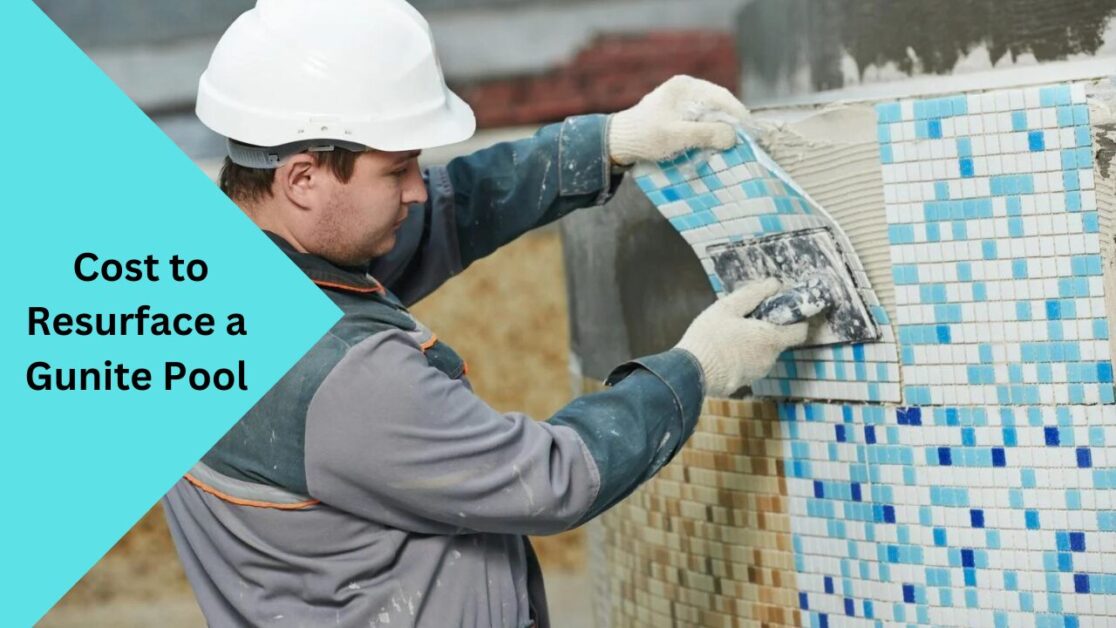Picture yourself on a warm summer day, lounging by your backyard pool. The sparkling water offers a refreshing escape from the scorching heat. However, over time, even the most well-maintained pools can show signs of wear and tear. If you own a gunite pool, you might wonder: How much does it cost to resurface a gunite pool? In this comprehensive guide, we’ll explore the cost and process of resurfacing your gunite pool, ensuring you can dive into a pool that looks as good as new.
Gunite pools, known for their durability and longevity, are constructed by spraying a mixture of sand, cement, and water onto a steel-reinforced framework. While gunite pools are built to last, the harsh effects of chemicals, weather elements, and general wear can lead to the need for resurfacing. By resurfacing your gunite pool, you not only rejuvenate its appearance but also enhance its structural integrity. Let’s dive deeper into the cost and process of resurfacing a gunite pool.
Understanding Gunite Pools and Resurfacing:
Gunite pools have become a popular choice among homeowners due to their ability to withstand heavy usage and adverse conditions. Unlike vinyl or fiberglass pools, gunite pools provide exceptional flexibility in design, allowing you to create a custom oasis in your backyard. However, even with their robust construction, gunite pools require maintenance and occasional resurfacing.
Over time, the gunite pool’s surface may develop cracks, stains, or rough textures. This deterioration not only affects the pool’s aesthetic appeal but can also lead to discomfort or injuries. By resurfacing the pool, the worn-out surface is replaced with a fresh, smooth, and visually appealing finish, restoring your pool’s charm and making it safe for everyone to enjoy.here is complete guide about How to Find a Leak in a Gunite Pool: A Comprehensive Guide
Factors Affecting the Cost of Resurfacing:
The cost of resurfacing a gunite pool can vary depending on several factors. Understanding these factors will help you estimate the potential expenses involved in reviving your pool. Here are the primary elements influencing the cost of gunite pool resurfacing:
- Pool Size and Shape: The dimensions and shape of your pool play a significant role in determining the resurfacing cost. Larger pools generally require more materials and labor, resulting in higher overall expenses. Additionally, irregularly shaped pools or those with intricate details may increase the complexity of the resurfacing process, affecting the cost.
- Pool Condition and Repairs: The current condition of your pool and any required repairs can impact the resurfacing cost. Extensive cracks, structural damage, or plumbing issues may necessitate additional repairs before resurfacing can take place. These repairs add to the overall cost but are essential for ensuring a long-lasting and quality finish.
- Geographical Location: The geographical location of your pool can affect the cost due to variations in labor rates and material availability. Urban areas or regions with higher living costs tend to have higher resurfacing expenses compared to rural areas.
- Quality and Type of Materials: The choice of materials for resurfacing significantly impacts the overall cost. From traditional plaster finishes to more durable options like pebble or quartz, each material has different price ranges. Quality materials may have a higher upfront cost but can potentially extend the lifespan of your pool’s surface.
It’s important to consider these factors when obtaining quotes or estimates from professionals. Each pool’s unique characteristics and requirements will contribute to the final cost of the resurfacing project.
Related post for you : Gunite Pool vs Fiberglass Pool: is the Best Option for Backyard Oasis?
Cost Breakdown of Gunite Pool Resurfacing:
To give you a better idea of what to expect, let’s break down the typical costs involved in resurfacing a gunite pool. Keep in mind that these numbers are approximate and can vary depending on the aforementioned factors and your location:
- Materials: The cost of materials constitutes a significant portion of the overall expense. On average, you can expect to spend between $4,000 to $7,000 on materials for resurfacing a gunite pool. This includes plaster, pebble, quartz, or any other finish you choose.
- Labor: Hiring professionals to complete the resurfacing project ensures a high-quality finish and reduces the risk of errors. Labor costs typically range from $3,000 to $5,000, accounting for the preparation, surface cleaning, repairs, and application of the chosen finish.
- Additional Expenses: Depending on your pool’s condition and specific requirements, there may be additional expenses to consider. For example, plumbing repairs, tile replacement, or equipment upgrades can increase the overall cost. It’s crucial to assess your pool’s needs and factor in these potential expenses during the planning stage.
By having a clear understanding of the cost breakdown, you can budget effectively and make informed decisions when it comes to resurfacing your gunite pool. Remember, these numbers are estimates, and obtaining personalized quotes from reputable professionals is essential for accurate costing.
Process of Resurfacing a Gunite Pool:
Now that we’ve explored the factors and costs, let’s dive into the step-by-step process involved in resurfacing a gunite pool. While it’s recommended to hire professionals for a smooth and hassle-free experience, understanding the general steps will help you communicate effectively with the experts. Here’s an overview of the resurfacing process:
- Assessment and Preparation: A professional pool contractor will assess your pool’s condition, identifying any cracks, stains, or damage. The pool will be drained, and necessary repairs, including fixing leaks or structural issues, will be undertaken. It’s crucial to address these issues before proceeding with resurfacing to ensure a long-lasting result.
- Surface Cleaning: The pool’s surface is thoroughly cleaned, removing any debris, algae, or mineral deposits. Proper preparation of the surface is essential to ensure good adhesion of the new finish.
- Application of New Finish: Depending on your preference and budget, the chosen finish – whether it’s plaster, pebble, quartz, or another option – will be expertly applied to the prepared surface. The number of coats may vary, and professionals will ensure a smooth and even texture.
- Curing and Start-up: Once the new finish is applied, it will need time to cure properly. The pool will be filled with water, and the necessary chemicals will be added to balance the water chemistry. It’s important to follow the specific instructions provided by the professionals to maintain the finish and protect your investment.
The duration of the resurfacing process can vary based on the pool’s size, condition, and the chosen finish. On average, you can expect the project to take anywhere from a few days to a couple of weeks. Proper maintenance and regular cleaning will help extend the lifespan of your pool’s new surface.
DIY vs. Professional Resurfacing:
When considering resurfacing your gunite pool, you might be tempted to tackle the project yourself in an attempt to save money. While DIY projects can be fulfilling, it’s crucial to weigh the advantages and disadvantages before making a decision.
DIY Resurfacing:
Pros:
- Potential cost savings on labor
- Complete control over the timeline and process
Cons:
- High risk of errors or lack of expertise in pool resurfacing techniques
- Limited access to professional-grade materials and tools
- Voiding existing warranties or insurance coverage
- Potential for longer project duration and increased costs due to mistakes
Professional Resurfacing:
Pros:
- Expertise and quality results backed by experience
- Access to professional-grade materials and tools
- Assurance of warranties or guarantees on workmanship
- Time-saving and efficient process
- Avoidance of potential mistakes and costly repairs
Cons:
- Higher upfront cost compared to DIY projects
- Dependence on professionals’ availability and schedule
Hiring professionals for your pool resurfacing project ensures peace of mind and a high-quality finish that will stand the test of time. The investment in professional expertise pays off in the form of a long-lasting, aesthetically pleasing, and properly functioning pool surface.
Check our latest article about How Long Does It Take to Build Gunite Pool: A Comprehensive Guide
Additional Considerations and Costs:
While resurfacing your gunite pool is the primary focus, it’s essential to consider any additional considerations and costs that may arise during the process. Here are some points to keep in mind:
- Retiling: Depending on the state of your pool’s tiles, you may need to replace or repair them during the resurfacing process. Discuss this aspect with the professionals and factor in the costs accordingly.
- Equipment Replacement or Upgrades: Resurfacing presents an opportunity to assess your pool’s equipment, such as pumps, filters, or lighting. If any components are outdated or showing signs of wear, consider replacing or upgrading them while the pool is being resurfaced.
- Landscaping and Surrounding Areas: Resurfacing your pool may require moving or protecting surrounding objects, landscaping, or outdoor furniture. Plan for potential costs in terms of temporary storage, landscaping restoration, or any modifications required.
While these additional considerations may increase the overall cost, they allow you to address multiple aspects of your pool’s renovation simultaneously, saving time and potential disruptions in the future.
Conclusion:
Congratulations, you’ve taken the plunge into understanding the cost and process of resurfacing a gunite pool! With the information provided, you are now equipped to make informed decisions and budget effectively for your pool’s transformation. Investing in the resurfacing of your gunite pool not only revives its appearance but also improves its durability, ensuring years of enjoyment for you, your family, and friends.
Remember to assess your pool’s condition, obtain personalized quotes from reputable professionals, and consider any potential additional needs or upgrades. By taking these steps, you’ll be well on your way to ensuring a beautiful, functional, and inviting gunite pool that your loved ones will cherish for years to come.

Greetings, fellow pool enthusiasts! I’m Turner Davis, your dedicated guide to the world of pool care and maintenance. With over a decade of experience in the field, I’ve made it my mission to transform ordinary pools into extraordinary aquatic retreats.

